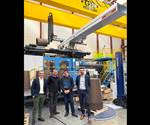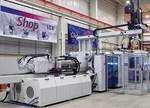Automation: New A-C Servo Axis Reduces Weight, Boosts Robot’s Payload
A newly developed direct drive from Wittmann Battenfeld and a re-design of the supporting structure has lightened the unit by 40% over its predecessor.
During a virtual introduction of products it would have launched at the Fakuma show, Wittmann Battenfeld introduced a new version of its A-C servo axis. Positioned at the end of the robot arm, the A-, B- and C-axes provide a “wrist” for cartesian style robots to maneuver the end-of-arm-tool (EOAT).
In the press conference, Wittmann Battenfeld Managing Director Michael Wittmann said the total weight of the new unit is 40% less compared to the previous version, with an average of 6 kg more payload handling available. This was achieved through the use of direct drives to power the wrist’s movements. Available for robots from the Wx142 to Wx153 and comparable units from the W8 pro series, the new A-C Servo Axis can be retrofitted to existing Wittmann Battenfeld robots and will be available for delivery in the fourth quarter of 2020.

The new A-C servo axis from Wittmann Battenfeld has reduced its own weight to boost the overall payload of the robot arm.
From the outside, the company says hardly any changes are visible, as its dimensions of 250 by 248 by 179 mm have been kept virtually unaltered. The newly developed direct drive and a redesign of the supporting structure, has reduced its overall weight and boosted the payload for the complete robot, but the drive performance for the A rotation (0–270°) and the C rotation (0–180°) remains unchanged, according to Wittmann.
Thanks to the decentralized drive control system from Wittmann, where the drive controllers are installed close to the motors, molders will be able to upgrade robots in the field with the new wrist without “elaborate” new wiring, according to the company. The R8 robot control system is able to control up to 12 servo axes—both linear and rotatory—with a cycle time of 4 ms and without an additional software package.
Related Content
-
Real-Time Production Monitoring as Automation
As an injection molder, Windmill Plastics sought an economical production monitoring system that could help it keep tabs on its shop floor. It’s now selling the “very focused” digital supervisor it created, automating many formerly manual tasks.
-
Processing Megatrends Drive New Product Developments at NPE2024
It’s all about sustainability and the circular economy, and it will be on display in Orlando across all the major processes. But there will be plenty to see in automation, AI and machine learning as well.
-
Drones and Injection Molding Ready for Takeoff
Drones and unmanned aerial vehicles (UAV) are approaching an inflection point where their production volumes — and functionality — will increasingly point to injection molding.












